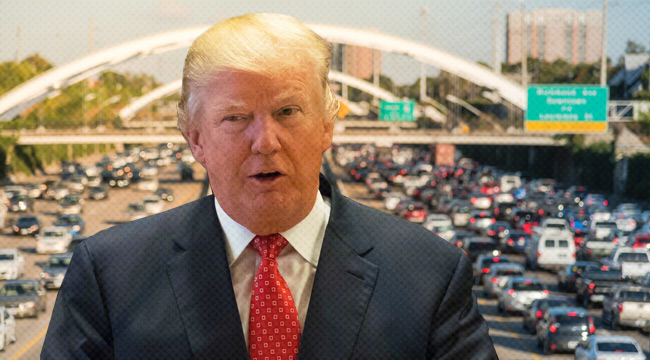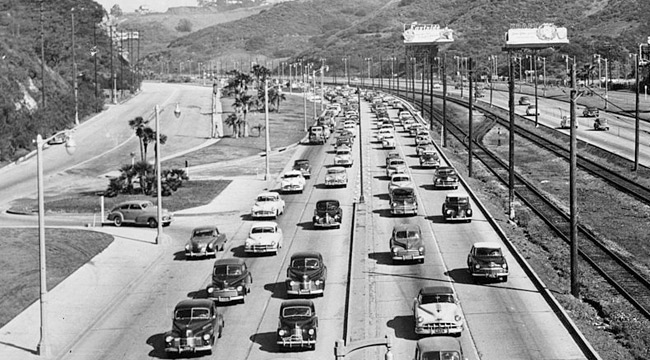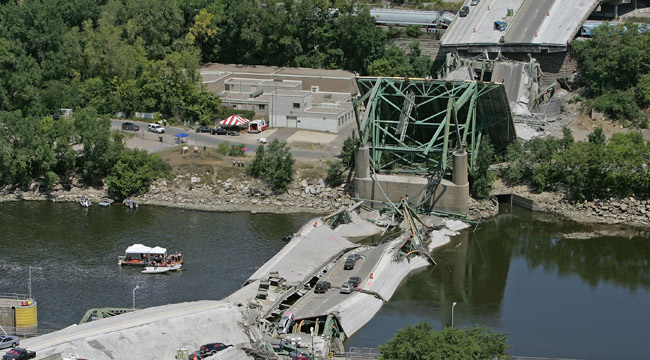
It’s a problem that’s so readily acknowledged by Americans that it was one of the few agreed-upon points in last year’s contentious election: our country’s infrastructure is crumbling, and something needs to be done about it, and quickly. As our system of roads and bridges continue to age, without proper upkeep, the situation is growing from an inconvenience to an outright danger.
Currently, more than $100 billion is wasted each year thanks to gridlock, one in every ten bridges is in immediate need of repair or replacement, and recently, a California dam’s auxiliary spillway came so close to failing that it prompted mass evacuations.
This sorry state is an about-face from a long-ago era when investment in our infrastructure was the very face of American ingenuity and a bipartisan source of pride that reflected the can-do spirit of the entire nation. So what exactly happened to that gung-ho enthusiasm? And is there anything that Trump’s administration is planning (besides that border wall) that feels like a new idea or a real, long-term solution to the problem? Oh, and can he achieve the task without plunging us further into debt?
Where We Started

With the Great Depression ongoing in 1935, President Franklin D. Roosevelt helped to usher in the Works Progress Administration (WPA), an agency that put some eight million people to work renovating schools, hospitals, airports, and water treatment plants. They also paved hundreds of thousands of miles of road. It was a massive achievement. The scope and effectiveness are still oft-cited and highly regarded when people talk about government’s ability to marshall resources and accomplish something. But of course, we don’t really do that kind of thing anymore.
During World War II, the program was shuttered, but when the war ended, our national investment in infrastructure continued as President Eisenhower signed the Federal Aid Highway Act in 1956, creating the interstate system. Where that history ends, today’s problems begin. Roads don’t last forever. At some point, we’re going to have to build-over the work done by our ancestors. And as with all herculean tasks: being proactive would be the best approach.
The Partisanship Of Investment

Each administration has touted their own infrastructure spending bill in recent history, and each one has been met with a different reaction from Congress. For example, the same year the Interstate Freeway System was completed in 1992, President Bill Clinton had spent just north of $40 billion on infrastructure investment, a trend that continued annually through the duration of his tenure, much like he promised in his first State of the Union. But Clinton’s investments went beyond the usual roads-and-bridges, with much of his focus spent on building up the technological infrastructure, providing schools and community centers with reliable access to the internet.
Clinton’s successor, George W. Bush, signed a transportation bill in 2005 that invested $286 billion dollars into infrastructure spending. Like the WPA, it was intended to work towards solving two problems at once: fix our roads and bridges, and put people to work while the nation was struggling with an unresponsive economy, boasting that every billion dollars spent would be another 47,000 people with a job. It did have bipartisan support, but opponents faulted it for an exceptional amount of wasteful earmarks.
It was also seen as a surrender on the part of Bush, who just two years earlier had vowed to end excessive government spending. While it wasn’t the first time a multi-billion dollar spending bill was criticized, it showed how infrastructure was becoming a partisan hot-button subject.
Infrastructure was also a central aspect of President Obama’s stimulus bill in 2009, as was his intent to form a federal bank that would free up $60 billion each year for roads that would, in turn, generate money back to the federal government. It was aimed at tamping down the stigma of excessive federal spending, reframing it as an investment, though he was ultimately unable to garner enough support for the plan.
Other spending bills Obama championed were regularly blocked by the Republican-backed Congress, although in 2015, he pushed through a $305 billion spending bill, the largest infrastructure bill since Bush’s a decade earlier. It received overwhelming support, though the bulk of the opposition came from Republicans.
Where Do We Go From Here (And How?)

All the spending bills from the prior three administrations haven’t been enough to truly address the problems of our infrastructure, which has been rated as a solid D+ by the The American Society of Civil Engineers (ASCE). Though it was up (slightly) from their report from four years ago. That report also calls for about a $3 trillion dollar investment by 2020 in order to receive an acceptable grade, which is likely to increase drastically when the 2017 report becomes available on March 7.
Interestingly enough, back in December of 2015, Trump, referring to the money the U.S. has spent on military operations, said “If we could’ve spent that $4 trillion in the United States to fix our roads, our bridges and all of the other problems — our airports and all of the other problems we’ve had — we would’ve been a lot better off.”
After the election, then-President Elect Trump continued to speak about our ailing infrastructure, promising to “rebuild our infrastructure, which will become, by the way, second to none,” with the added bonus that “we will put millions of our people to work as we rebuild it.” It’s an appealing proposition to those across the political spectrum (specifically, Democrats), and it’s even seen as the first platform where Republicans and Democrats could find common ground and work together in the new Congress.
And that’s good because the reality is that spending on our infrastructure has significantly lowered in recent years, as BCA Research pointed out back in 2013. While it has remained a consistent percentage of our GDP, it should be pointed out that costs for raw materials have also increased, meaning there are less physical repairs being done overall. Compare that to China, where they spend about 20 times what the U.S. does (less than roughly one-half percent of GDP annually), freeing them to tackle incredibly ambitious projects like the overnight demolition of a freeway overpass.
But will Trump’s actual infrastructure plan address these problems? According to The Transport Politic, the plan itself revolves around tax credits intended to motivate private companies to step in for these projects. The main problem there is that projects that were unlikely to generate a profit would likely remain untouched. Similarly, as Paul Krugman opined in The New York Times, this proposal is essentially the privatization of our public utilities, which is raising eyebrows on both sides of the aisle.
Trump’s plan would, however, also results in less federal spending, meaning it could evade the stigma of added debt and increased taxes, which is what derailed many of the bills that Obama proposed during his two terms.
Either way, it’s increasingly clear that federal spending will need to increase, and the public is on the side of action. Last year Gallup had 75% of Americans in favor of spending more with only 11% against it.
Still, despite all that, infrastructure will remain another abstract political talking point until politicians are able to agree upon a solution and the necessary funds to repair and modernize our outdated system, freeing us all from the danger that our roads, bridges, dams, and airports will continue to crumble and be less safe.
